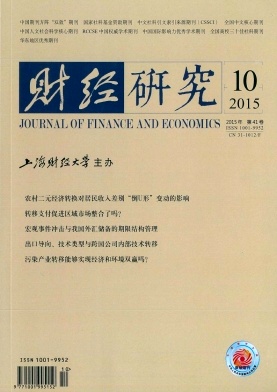宏观事件冲击与我国外汇储备的期限结构管理——基于美债上限调整的事件研究
财经研究 2015 年 第 41 卷第 10 期, 页码:
摘要
参考文献
摘要
近年来,发达国家的主权信用风险日益成为威胁外汇资产安全的重要因素,而我国单一集中的期限配置方式并不利于抵御外来冲击、防范信用风险。在此背景下,文章构建了宏观事件冲击下不同期限主权信用风险调整及影响因素的理论分析框架,并以美国20次提高债务上限作为重大冲击,实证检验了不同期限主权信用风险调整及其影响因素。结果表明:(1)美债上限提高引发了主权信用风险调整,事件前短期风险增大而长期风险减小,事件后短期风险减小而长期风险增大;(2)长期风险调整取决于经济、财政和货币环境等基本面因素,而短期风险调整主要受到美元走势、交易活跃度和投资者情绪等市场环境的影响。因此,政府应充分利用宏观事件冲击下的期限套利机会,综合考虑经济环境和市场因素,适时适度调整资产期限结构,以实现我国外汇资产的保值增值。
[1]陈珂,成博,杨胜刚.我国外汇储备投资期限配置实证研究[J].经济管理,2013,(8):126-133.
[2]齐天翔,葛鹤军.信用利差的影响因素文献综述[J].科学决策,2014,(6):80-94.
[3]徐苏江,黄运成.主权信用违约掉期市场发展现状及功能分析[J].国际金融研究,2010,(11):81-86.
[4]徐永林,张志超.外汇储备币种结构管理:国际研究综述[J].世界经济,2010,(9):3-27.
[5]张志超.最优国际储备理论与测度:文献述评(上)[J].华东师范大学学报(哲学社会科学版),2009,(2):94-104.
[6]郑振龙.资产价格隐含信息分析框架:目标、方法与应用[J].经济学动态,2012,(3):33-40.
[7]Arellano C, Ramanarayanan A. Default and the maturity structure in sovereign bonds[J]. Journal of Political Economy, 2012, 120(2): 187-232.
[8]Arora V, Cerisola M. How does US monetary policy influence sovereign spreads in emerging markets?[R]. IMF Staff Papers, 2001.
[9]Balduzzi P, Elton E J, Green T C. Economic news and bond prices: Evidence from the US treasury market[J]. Journal of Financial and Quantitative Analysis, 2001, 36(4): 523-543.
[10]Bernoth K, Von Hagen J, Schuknecht L. Sovereign risk premiums in the European government bond market[J]. Journal of International Money and Finance, 2012, 31(5): 975-995.
[11]Blanchard O J. Suggestions for a new set of fiscal indicators[R]. OECD Economics Department Working Papers No. 79, 1990.
[12]Broner F A, Lorenzoni G, Schmukler S L. Why do emerging economies borrow short term?[J]. Journal of the European Economic Association, 2013, 11(S1): 67-100.
[13]Butler A W, Fauver L. Institutional environment and sovereign credit ratings[J]. Financial Management, 2006, 35(3): 53-79.
[14]Cantor R, Packer F. Determinants and impact of sovereign credit ratings[J]. Economic Policy Review, 1996, 2(2): 86-98.
[15]Cole H L, Kehoe T J. A selffulfilling model of Mexico’s 1994-1995 debt crisis[J]. Journal of International Economics, 1996, 41(3): 309-330.
[16]Fontana A, Scheicher M. An analysis of euro area sovereign CDS and their relation with government bonds[R]. ECB Working Paper No.1271, 2010.
[17]Klepsch C, Wollmershuser T. Yield spreads on EMU government bonds-How the financial crisis has helped investors to rediscover risk[J]. Intereconomics, 2011, 46(3): 169-176.
[18]Manganelli S,Wolswijk G. Market discipline, financial integration and fiscal rules: What drives spreads in the euro area government bond market?[R]. European Central Bank Working Paper No. 745, 2007.
[19]Roger S. The management of foreign exchange reserves[R]. Bank for International Settlements, Monetary and Economic Department, 1993.
[20]Schuknecht L, Von Hagen J, Wolswijk G. Government risk premiums in the bond market: EMU and Canada[J]. European Journal of Political Economy, 2009, 25(3): 371-384.
[21]Pan J, Singleton K J. Default and recovery implicit in the term structure of sovereign CDS spreads[J]. Journal of Finance, 2008, 63(5): 2345-2384.
[2]齐天翔,葛鹤军.信用利差的影响因素文献综述[J].科学决策,2014,(6):80-94.
[3]徐苏江,黄运成.主权信用违约掉期市场发展现状及功能分析[J].国际金融研究,2010,(11):81-86.
[4]徐永林,张志超.外汇储备币种结构管理:国际研究综述[J].世界经济,2010,(9):3-27.
[5]张志超.最优国际储备理论与测度:文献述评(上)[J].华东师范大学学报(哲学社会科学版),2009,(2):94-104.
[6]郑振龙.资产价格隐含信息分析框架:目标、方法与应用[J].经济学动态,2012,(3):33-40.
[7]Arellano C, Ramanarayanan A. Default and the maturity structure in sovereign bonds[J]. Journal of Political Economy, 2012, 120(2): 187-232.
[8]Arora V, Cerisola M. How does US monetary policy influence sovereign spreads in emerging markets?[R]. IMF Staff Papers, 2001.
[9]Balduzzi P, Elton E J, Green T C. Economic news and bond prices: Evidence from the US treasury market[J]. Journal of Financial and Quantitative Analysis, 2001, 36(4): 523-543.
[10]Bernoth K, Von Hagen J, Schuknecht L. Sovereign risk premiums in the European government bond market[J]. Journal of International Money and Finance, 2012, 31(5): 975-995.
[11]Blanchard O J. Suggestions for a new set of fiscal indicators[R]. OECD Economics Department Working Papers No. 79, 1990.
[12]Broner F A, Lorenzoni G, Schmukler S L. Why do emerging economies borrow short term?[J]. Journal of the European Economic Association, 2013, 11(S1): 67-100.
[13]Butler A W, Fauver L. Institutional environment and sovereign credit ratings[J]. Financial Management, 2006, 35(3): 53-79.
[14]Cantor R, Packer F. Determinants and impact of sovereign credit ratings[J]. Economic Policy Review, 1996, 2(2): 86-98.
[15]Cole H L, Kehoe T J. A selffulfilling model of Mexico’s 1994-1995 debt crisis[J]. Journal of International Economics, 1996, 41(3): 309-330.
[16]Fontana A, Scheicher M. An analysis of euro area sovereign CDS and their relation with government bonds[R]. ECB Working Paper No.1271, 2010.
[17]Klepsch C, Wollmershuser T. Yield spreads on EMU government bonds-How the financial crisis has helped investors to rediscover risk[J]. Intereconomics, 2011, 46(3): 169-176.
[18]Manganelli S,Wolswijk G. Market discipline, financial integration and fiscal rules: What drives spreads in the euro area government bond market?[R]. European Central Bank Working Paper No. 745, 2007.
[19]Roger S. The management of foreign exchange reserves[R]. Bank for International Settlements, Monetary and Economic Department, 1993.
[20]Schuknecht L, Von Hagen J, Wolswijk G. Government risk premiums in the bond market: EMU and Canada[J]. European Journal of Political Economy, 2009, 25(3): 371-384.
[21]Pan J, Singleton K J. Default and recovery implicit in the term structure of sovereign CDS spreads[J]. Journal of Finance, 2008, 63(5): 2345-2384.
引用本文
黄晓薇, 贾君怡, 郭 敏. 宏观事件冲击与我国外汇储备的期限结构管理——基于美债上限调整的事件研究[J]. 财经研究, 2015, 41(10): 0.
导出参考文献,格式为:





 8151
8151  4278
4278

